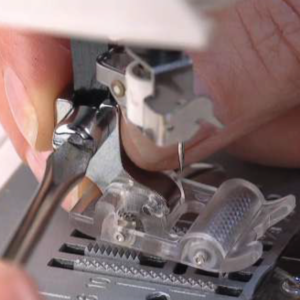
The Roller Foot can be used to sew thicker fabrics, napped fabrics, heavy knits, leather, vinyl, or any heavier weight fabrics that are difficult to feed. The foot has two sets of rollers, one large which is to the front and two small rollers at the back of the foot. This allows the fabric to pass under the foot smoothly.
Depending on your machine model, the foot may have its own shank or it may simply snap on and off the machine.
In addition, some versions of the foot are made from a non-stick material while others are metal. Regardless of the style, the feet essentially work in the same way.
The Roller Foot can be used in place of a General Purpose Foot with the added benefit of allowing most thicker fabrics, napped fabrics, heavy knits, leather, vinyl, or any heavier weight fabrics that are difficult to feed pass under the foot easily.
If your Roller Foot is a snap on style, simply remove the General Purpose Foot from the presser foot holder and snap on the Roller Foot, following the recommendations in your machine manual.
If your Roller Foot comes with its own shank, attach it by first removing the General Purpose foot and presser foot with a screwdriver.
Attach the roller foot to the shank using the same screw and small screwdriver.
To sew with the Roller Foot on leather fabrics, use a straight stitch on your Singer Sewing Machine and set the stitch length to a medium-long stitch length.
A smaller stitch may perforate the fabric causing it to tear away from the seam.
Tip - When working with leather, plastic, oilcloth and laminated fabrics try using paper clips instead of pins to hold the layers of fabric together as you sew. Pins will make permanent holes in these speciality fabrics.
To sew heavy knit fabrics with the Roller Foot use a narrow zig-zag stitch or straight stitch at an average stitch length.
Stitch Length

Increase your stitch length on your Singer Sewing Machine to a 3 setting when sewing leather, plastic, oilcloth and laminated fabrics.
A shorter stitch length can cause the fabric perforated at the seamline and tear.
